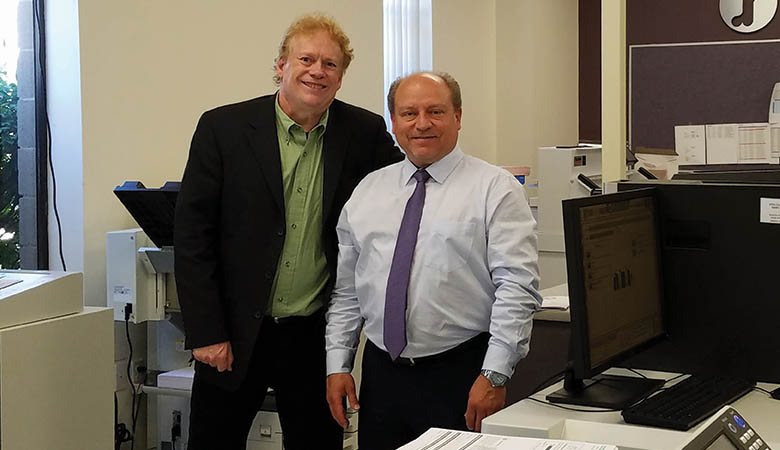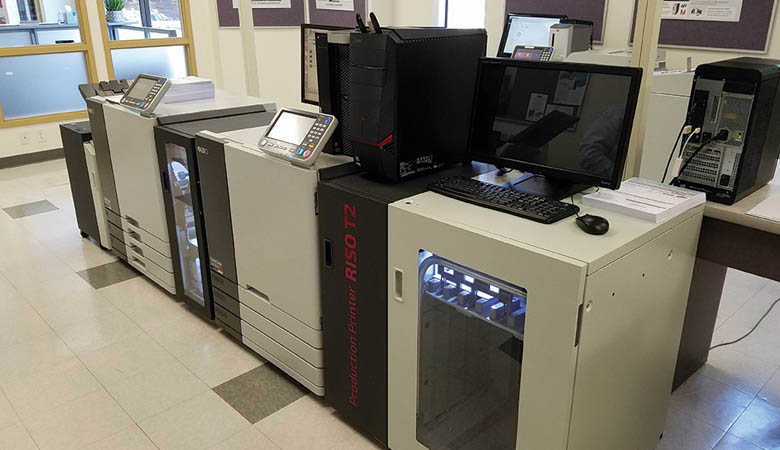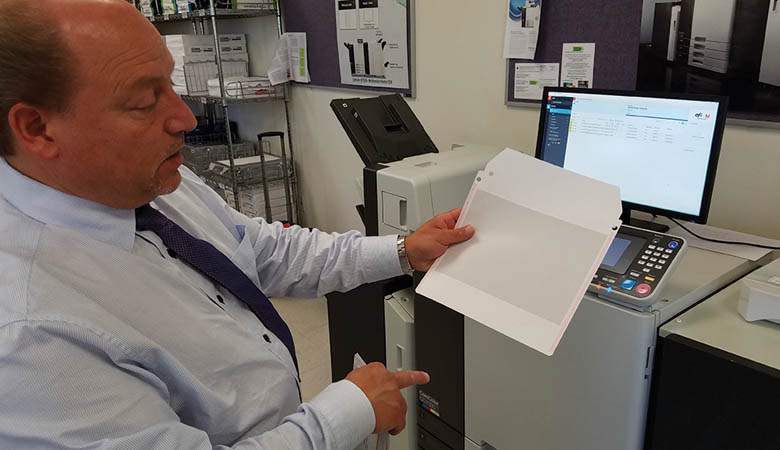Filling the Gaps with RISO and Cut-Sheet Inkjet Technology
Top: A visit to RISO isn’t complete without touring its in-house print shop to see its inkjet printers in action. Above: The CR’s Editor-in-Chief Scott Cullen with RISO’s Andre D’Urbano in RISO’s in-house print shop. Below:
Many dealers still think of RISO, Inc. as a digital duplicator company. They’re not wrong, but if Andre D’Urbano, RISO’s director of dealer sales and corporate marketing, has his way, dealers will start thinking of the company first and foremost as a provider of affordable, high-speed, cut-sheet inkjet technology.
That’s not a stretch. The company has been diligently building out its cut-sheet inkjet product offerings, not just for commercial print shops and in-plants, but for office use as well. Its ComColor line of inkjet machines comprises nine different products, including three in the FW Series and two in the GD Series. Prices range from a low of $25,000 to a high of $45,000 as standalone devices. The two GD units can be upgraded with various accessories for use as production devices in printshops and in-plants, raising the price to around $100,000.
You might think it odd that someone would be so jazzed about inkjet technology, but D’Urbano, who’s been around the imaging industry block for more than 30 years, including two separate stints with RISO, makes a compelling case for cutsheet inkjet devices, which are priced significantly lower, even when fully configured, than traditional high-speed inkjet and toner-based color production print machines selling at $900,000 and above. During a July visit to RISO’s U.S. headquarters in Burlington, Massachusetts, D’Urbano explained he’s not out to compete with high-end color toner or inkjet machines that print on all sorts of materials, including substrates, or color devices where print quality is one of the key selling points of the equipment. No, he’s talking about affordable spot color and color where the user isn’t scrutinizing image and color quality with a fine-tooth comb. These applications encompass brochures, manuals, and mail pieces, along with envelopes, which are often fodder for the recycling bin. RISO’s machines are not designed to print on glossy paper and all but one of the company’s machines does not print on 11 x 17 paper. If a customer requires a device that prints on glossy paper, D’Urbano suggests they look elsewhere.
Filling the Gap
One of the market research organizations that covers the imaging industry, and liberally likes to sprinkle “disruptive” into its analysis, has used that adjective to describe RISO’s inkjet machines. However, D’Urbano prefers “complementary,” explaining RISO is not out to disrupt the market for toner-based color devices in the office, the print shop, or the in-plant.
“I can see how it can be disruptive but simultaneously, this is just another piece of technology in the mix. To me, that’s complementary,” he said. “We allow you to do jobs that toner or offset don’t do as well.”
His message to the dealer community is that RISO’s inkjet machines fill the gap between high-speed black & white and color machines, whether it’s a commercial print shop, an in-plant, or an office.
D’Urbano makes a case for this technology that doesn’t use heat to lay an image down on a piece of paper or require customers to retrofit their electrical systems to accommodate the power needs of highend toner-based production machines with their internal heating and drying systems, which are necessary to dry the ink on the page. Because RISO’s inkjet machines use oil-based inks, a heater or dryer isn’t necessary.
Envelopes are a particularly sticky problem because of the glue on the back, which could create problems when run through some toner-based machines because of the heat.
“Because there’s no heat, you can run a substrate [like an envelope] that has glue on the back,” added D’Urbano.
Cost-Effective Color
The challenge for D’Urbano is getting his message across to dealers and customers who believe color is too expensive, or the quality of color inkjet isn’t on a par with color toner. He argues color inkjet is more profitable than mono toner for dealers and an excellent option for organizations that have shied away from color in the past because of the costs.
“The message here is that color inkjet is way more profitable than monochrome toner,” said D’Urbano. “There’s no money in monochrome. It’s a service [dealers] are offering to their customers. I keep telling customers, if you’re still printing in black & white, it’s because somebody’s convinced you that color’s too expensive.”
The cost per page with a color inkjet machine is approximately 1.2 cents versus 6.5 cents for a color toner-based device, according to D’Urbano. One might argue that it still costs less than a penny a page for black & white print output on a toner-based device, but here’s where D’Urbano highlights the impact color has, even if it’s spot color, when added to a document. He firmly believes some customers who have been printing everything in black & white will have no problem paying a little bit more for color once they understand how inexpensive it is to do.
His argument plays well in the print shop too because the print shop can get higher margins by offering customers color inkjet prints instead of black & white toner-based prints.
“When you look at the industry as far as what the retail market is charging, I go to the cheapest outlet, Staples,” explained D’Urbano. “They sell color for 11 cents and black & white for 2 cents. Most independent print shops will offer color for 12, 13, or 14 cents and black & white for 3 cents. If black & white is 3 cents and color is 12 cents and you come in with inkjet color at 5 cents, there’s that gap. This is what we’re trying to teach the dealers.” The message RISO relays to print shops is that they already have toner-based device, they’re no longer doing offset, but offering ink technology on a digital platform, allows them to provide customers with a more complete offering for their printed output.
“If they don’t have ink, they’re typically outsourcing envelopes, NCR””the types of jobs traditionally run with ink,” said D’Urbano.
Another objection is that inkjet output doesn’t look like toner to which D’Urbano responds, “Customers don’t know the difference between inkjet and toner, but they do know the difference between six cents and 12 cents.”
“In a print shop, that’s only $10 to produce 1,000 color envelopes,” said D’Urbano. “If a printer runs several small envelope jobs for customers on a montly basis, they can pay for the lease [on the machine]. We sell a lot of RISOs into these mid-size print shops because of the envelopes.”
It typically costs 20 to 25 cents an envelope, and then adding variable data such as a marketing message to the outside of the envelope raises the price to 40 cents per envelope above the base rate. When printed on a RISO machine, on an envelope of any size, the cost is a penny because it doesn’t use a lot of ink.
Inkjet in the Office
While D’Urbano makes a compelling case for inkjet in the print shop and the in-plant, he’s on an even more treacherous mission to bring inkjet into the office. He contends his inkjet machine can be a tool to help dealers sell more MFPs. If the dealer is looking to sell a customer three or four MFPs, adding an inkjet device into the mix changes the message from the competition’s, which is often focused on CPC. “When you sell RISO, it’s a bonus because you can make a lot of money selling RISO, but dealers need to look at it as a tool,” he said. “This is where we live. It’s a lot of black and white [material output] that people want to add a little bit of color here, a little bit of color there, and not have to pay six times the price. That’s why inkjet exists. We complement, complement, complement. You’re not going to get that message from Canon and Xerox because they don’t play in inkjet at this level. No one else is competing at this level.”
D’Urbano understands the trepidation dealers may have about selling inkjet into the office, particularly the fear of encouraging customers to switch their color pages from a toner-based device where the dealer is charging them 7 cents to an inkjet, where the customer might now be paying 2.5 cents per page for their color output.
“Their response is then akin to: “˜I have a customer paying 7 cents and you want me to upgrade our Toshiba with your RISO and charge them 2.5 cents?’ [They’re thinking] no, that would be bad business,” observed D’Urbano.
He understands where these dealers are coming from and tells them that if a customer is willing to pay 7 cents, don’t change, but consider viewing the RISO inkjet as a competitive knockout. He recommends dealers target competitive accounts, encouraging those accounts to move the color pages they’re paying 7 cents for on a color MFP to an inkjet and paying 2.5 cents per copy for color, all inclusive. This gives the rep something to sell when visiting a prospect that’s in the middle of a lease for their MFPs because the rep is selling a “complementary” product not out to replace the customer’s MFPs.
“If you’re up against seven competitors on a decent-sized deal and have a high risk of not winning the deal, why not say,
we’re going to sell you the Toshibas, but the color will be on this RISO inkjet?” noted D’Urbano. “Whereas the competition is selling the one for the same price, you’re selling the two. It’s a scary concept for dealers to understand they can use inkjet as a tool to sell more MFPs.”
In the meantime, D’Urbano, who is visiting and seeking opportunities to engage dealers, will be at the BTA event in New York in September, and PRINT18 in Chicago, advocating that dealers who take on inkjet focus on changing the conversation with their customers. It doesn’t have to be about speeds and feeds, and more prominently on price. The conversation can shift to applications and what types of materials are being produced that would be better served by an inkjet device.
For D’Urbano, this is a reality to consider, and he is committed to spreading this conviction for the foreseeable future.
Above: A demo of the RISO T2 was one of the highlights of our visit to RISO.
Above: D’Urbano demos how RISO’s inkjet machines, which don’t use heat, excel with substrates with glue, such as envelopes.
Access Related Content
Visit the www.thecannatareport.com. To become a subscriber, visit www.thecannatareport.com/register or contact cjcannata@cannatareport.com directly. Bulk subscription rates are also available.





